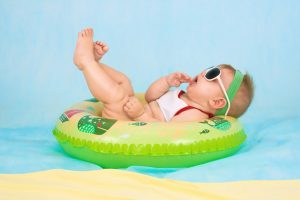Preschoolers love color! (Who doesn’t, really?) They also love science experiments. So, to complement our preschool color-themed games like Colorific, Sea of Colors, and Dino Parade, engage your little one in these color science experiments for preschoolers!
Below, we’ve outlined a simple color science experiment with fun and perfect variations for preschoolers! This fun activity introduces basic science, mathematical, and cognitive concepts, including measuring, following directions, cause and effect, and the scientific method.
What You’ll Need
- Test Tubes with Lids
- Food Coloring
- Eye Dropper
- Plastic egg carton, painting palette, or any container with small wells
- Paper Towels

Experiment #1: Dyeing the Water
Chances are your KneeBouncer may or may not be familiar with food coloring. First, help your child fill the test tube three-quarters full of water. Next, allow your child to add a few drops of food coloring to each tube.
Cap the test tube and let them shake away to mix!
Observations:
- What colors did we make?
- What happened to the water?
- What happened when you shook the tubes?
- Did what you expected to happen actually happen?
- Do you think we could change the colors? How do you think we could do that?
Experiment #2: Mixing Colors
Ensure the lids are tightly secured, and ask your child to take two test tubes and cross them while holding them up to a window or light if there’s no sunlight.
Observations:
What color is made when the two tubes cross?
Have them repeat this with another pair of colors.
Experiment #3: Mixing Colors with an Eye Dropper
Now it’s time to get some water play in! First, have your preschooler use an eye dropper to mix colors in the plastic egg carton or palette with an eye dropper. Before they mix, ask them to activate their prior knowledge about what happened in experiment #2.
Make predictions:
- What happened when we crossed blue with yellow?
- Will the same thing happen when we mix the yellow and blue water together?
- What do you think will happen when other color combinations are mixed together? Why?
Allowing children to experiment and discover on their own creates new neural pathways in their brains and supports healthy brain development.
Areas of Development These activities promote various STEM areas, including color recognition, measurement, estimation, cause and effect, problem-solving, prediction, reasoning, language development, fine motor control, following directions, sensory input, and scientific inquiry.
Update July 13, 2023, by L. Elizabeth Forry








